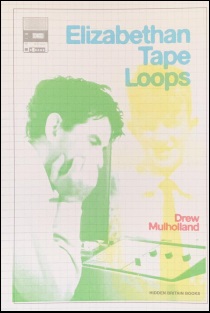Drew Mulholland - Elizabethan Tape Loops "This manipulation of sound is sympathetic magic; a sonic alchemy that creates pathways for both the retrieval of memory and their unexpected connections" writes Drew Mulholland, formerly of Glasgow retro-experimentalists Mount Vernon Arts Lab and currently a solo artist and now considered "the Godfather of hauntology". That accolade is largely due to his album The Séance At Hobbs Lane, which drew upon the film Quatermass and the Pit, psychogeographic investigations, occult societies and featured collaborations and remixes involving Portishead's Adrian Utley, Barry 7 of Add N to X, Coil and a number of fellow Glasgow musicians including Teenage Fanclub's Norman Blake, Electroscope's John Cavanagh and Belle and Sebastian's Isobel Campbell. Originally released in 2001 and subsequently reissued by Ghost Box Records it has become a touchstone for the genre. "This manipulation of sound is sympathetic magic; a sonic alchemy that creates pathways for both the retrieval of memory and their unexpected connections" writes Drew Mulholland, formerly of Glasgow retro-experimentalists Mount Vernon Arts Lab and currently a solo artist and now considered "the Godfather of hauntology". That accolade is largely due to his album The Séance At Hobbs Lane, which drew upon the film Quatermass and the Pit, psychogeographic investigations, occult societies and featured collaborations and remixes involving Portishead's Adrian Utley, Barry 7 of Add N to X, Coil and a number of fellow Glasgow musicians including Teenage Fanclub's Norman Blake, Electroscope's John Cavanagh and Belle and Sebastian's Isobel Campbell. Originally released in 2001 and subsequently reissued by Ghost Box Records it has become a touchstone for the genre. In Elizabethan Tape Loops he documents his journey into experimentalism and psychogeography (without explicitly using that term) from his early adolescence with his childhood friend - the book also acts a lovely tribute to friendship - who introduced the young Mulholland to the Sex Pistols (Mulholland dreamt of the Pistols being fronted by Sid James, an unlikely formation confirmed after spinning 'Anarchy In The UK' at the wrong speed turning Lydon's laughter into a Sid James cackle) and Pink Floyd's The Piper at the Gates of Dawn and the endless possibilities emanating from recording and tape loops. Fuelled by the enthusiasm of youth they spurred each other on borrowing titles on composing with tape recorders from the local mobile library, experimenting with looping and splicing tapes to making location recordings in the east end of Glasgow. It's a familiar story. Unlike Mulholland who was snagging books on musique concrète - and investigating terrorism. Here in Paisley we'd be seeking out occult titles from Paisley's libraries, swapping Colin Wilson books, struggling with Burroughs' cut-ups and building dream machines. There's a nice balance between fact and anecdote in Elizabethan Tape Loops. At times there are forays about the science of recording, the origin of the tape loop, and an explanation of Electronic Voice Phenomena, while elsewhere Mulholland relates a hilarious story around a Burroughs styled experiment of tape loops simulating a terrorist attack in his living room which caused something more than a storm in a tea cup. "The idea that landscape, memory, sound, divination, spirit of place, old maps, can hot wire elements from memory and the subconscious fascinates me. I also love the idea that scavenged material from a field trip can actually over time affect the oxide on the tape, therefore transforming it in a very real sense, an alchemical process." This is something Mulholland expands on around his explorations to film sites, graveyards, circulating libraries and disused railway stations that have informed releases such as The Wicker Tapes, A Trip To Hob Moor, Messer's Circulating Library. That last one was the one on the turntable when I was struck by an episode of labyrinthitis causing dizziness that lasted months. Like Drew Mulholland I've been known to spend a lot of time exploring these sites of significance but what is remarkable is the way he captures the atmosphere of those sites or mixes tapes in the detritus collected from their locations whether it's from the Wicker Man (still got fragments left here...) or the old Sex Pistols base on Denmark Street (behind the building where Hipgnosis had a design studio), and most notably to the debris picked from the garden of Syd Barrett's childhood home in Cambridge which were then glued to a piece of cardboard, played, recorded and worked into a new track. The sleeve of the subsequent lathe-cuts vinyls featured artwork using the paint mixed with the ground down garden detritus. The book is full of these intersections and connections which almost come full circle but the last word goes to a chat Mulholland had with his Delia Derbyshire who recounted a visit by Brian Jones to the BBC Radiophonic Workshop where they discussed sound manipulation. Delia Derbyshire is something of a pivotal figure for Mulholland, his album Three Antennas in a Quarry was based on one of her graphic scores gifted to him, while Sydelia Jones was an imaginary collaboration between Delia Derbyshire, Brian Jones and Syd Barrett. Since the publication of Elizabethan Tape Loops Mulholland has continued with his diverse sonic explorations on albums such as Muzak From The Korova Milkbar with The Galaxy Electric and Night Blooming Flowers a collaboration with Garden Gate. Still out there, still underground: the work of Drew Mulholland is well worth investigating. You can keep up to date with the activities of Drew Mulholland by following him on Instagram Elizabethan Tape Loops is published by Hidden Britain and while sold out at source you can hopefully still track a copy down. |

